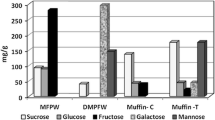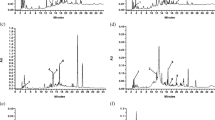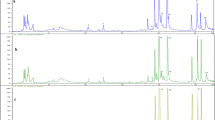Abstract
The food industry produces a large amount of onion wastes, making it necessary to search for possible ways for their utilization. One way could be to use these onion wastes as a natural source of high-value functional ingredients, since onion are rich in several groups of compounds, which have perceived benefits to human health. The objective of this work is to gain knowledge of any differences between the different onion wastes obtained from industry and non-commercial bulbs to use them as food ingredients rich in specific compounds. The results showed that brown skin and top–bottom could be potentially used as functional ingredient rich in dietary fibre, mainly in insoluble fraction, and in total phenolics and flavonoids, with high antioxidant activity. Moreover, brown skin showed a high concentration of quercetin aglycone and calcium, and top–bottom showed high concentration of minerals. Outer scales could be used as source of flavonols, with good antioxidant activity and content of dietary fibre. However, inner scales could be an interesting source of fructans and alk(en)yl cystein sulphoxides. In addition, discarded onions (cvs Recas and Figueres) could be used as a good source of dietary fibre, and cv Recas also as a source of phenolics compounds.
Similar content being viewed by others
Abbreviations
- ACSOs:
-
alk(en)yl cystein sulphoxides
- DF:
-
Dietary fibre
- DM:
-
Dry matter
- DP:
-
Degree of polymerization
- FOS:
-
Fructooligosaccharides
- FRAP:
-
Ferric reducing ability assay
- GAE:
-
Galic acid equivalents
- ICP-MS:
-
Inductively coupled plasma mass spectrometry
- IDF:
-
Insoluble dietary fibre
- MCSO:
-
(+)-S-methyl-L-cysteine sulphoxide
- NSC:
-
non-structural carbohydrates
- PCSO:
-
(+)-S-propyl-L-cysteine sulphoxide
- PECSO:
-
trans-(+)-S-1-propenyl-L-cysteine sulphoxide
- QE:
-
Quercetin equivalents
- SDF:
-
Soluble dietary fibre
- TDF:
-
Total dietary fibre
- TFA:
-
Trifluoroacetic acid
References
FAO Statistics (2008) Productions, crops. Retrieved February 15 from http://faostat.fao.org/site/567/default.aspx#ancor
Waldron KW (2001) Useful ingredients from onion waste. Food Sci Technol 15(2):38–41
Griffiths G, Trueman L, Crowther T, Thomas B, Smith B (2002) Onions-a global benefit to health. Phytother Res 16:603–615
Abayomi LA, Terry LA (2009) Implications of spatial and temporal changes in concentration of pyruvate and glucose in onion (Allium cepa L.) bulbs during controlled atmosphere storage. J Sci Food Agric 89:683–687
Downes K, Chope GA, Terry LA (2010) Postharvest application of ethylene and 1-methylcyclopropene either before or after curing affects onion (Allium cepa L.) bulb quality during long term cold storage. Postharvest Biol Technol 55:36–44
Davis F, Terry LA, Chope GA, Faul CFJ (2007) Effect of extraction procedure on measured sugar concentrations in onion (Allium cepa L.) bulbs. J Agric Food Chem 55:4299–4306
Jaime L, Martín-Cabrejas MA, Mollá E, López-Andréu FJ, Esteban RM (2001) Effect of storage on fructan and fructooligosaccharide of onion (Allium cepa L.). J Agric Food Chem 49:982–988
Playne MJ, Bennett LE, Smithers GW (2003) Functional dairy foods and ingredients. Aust J Dairy Technol 58:242–264
Jaime L, Mollá E, Fernández A, Martín-Cabrejas MA, López-Andréu FJ, Esteban RM (2002) Structural carbohydrate differences and potencial source of dietary fiber of onion (Allium cepa L.) tissues. J Agric Food Chem 50:122–128
Santas J, Carbó R, Gordon MH, Almajano MP (2008) Comparison of the antioxidant activity of two Spanish onion varieties. Food Chem 107:1210–1216
Downes K, Chope GA, Terry LA (2009) Effect of curing at different temperatures on biochemical composition of onion (Allium cepa L.) skin from three freshly cured and cold stored UK-grown onion cultivars. Postharvest Biol Technol 54:80–86
Roldán-Marín E, Sánchez-Moreno C, Lloría R, de Ancos B, Cano MP (2009) Onion high-pressure processing: Flavonol content and antioxidant activity. LWT Food Sci Technol 42:835–841
Yao LH, Jiang YM, Shi J, Tomás-Barberán FA, Datta N, Singanusong R, Chen SS (2004) Flavonoids in food and their health benefits. Plant Foods Hum Nutr 59:113–122
Randle WM, Lancaster JE, Shaw ML, Sutton KH, Hay RL, Bussard ML (1995) Quantifying onion flavour compounds responding to sulfur fertility-sulfur increases levels of alk(en)yl cysteine sulfoxides and biosynthetic intermediates. J Am Soc Hortic Sci 120(6):1075–1081
Mallor C, Thomas B (2008) Resource allocation and the origin of flavour precursors in onion bulbs. J Hortic Sci Biotechnol 83(2):191–198
Osmont KS, Arnt CR, Goldman IL (2003) Temporal aspects of onion-induced antiplatelet activity. Plant Foods Hum Nutr 58:27–40
Rose P, Whiteman M, Moore PK, Zhu LZ (2005) Bioactive S-alk(en)yl cysteine sulfoxide metabolites in the genus Allium: The chemistry of potential therapeutic agents. Nat Prod Rep 22:351–368
AOAC (1995) Methods of Analysis, 16th ed. Washington, DC: Association of Official Analytical Chemists
Chope GA, Terry LA, White PJ (2006) Effect of controlled atmosphere storage on abscisic acid concentration and other biochemical attributes of onion bulbs. Postharvest Biol Technol 39:233–242
Terry LA, Chope GA, Bordonaba JG (2007) Effect of water deficit irrigation and inoculation with Botrytis cinerea on strawberry (Fragaria x ananassa) fruit quality. J Agric Food Chem 55:10812–10819
Sinclair PJ, Blakeney AB, Barlow EWR (1995) Relationships between bulb dry matter content, soluble solids concentration and non-structural carbohydrate composition in the onion (Allium cepa L.) bulbs. J Sci Food Agric 69:203–209
Ariyama K, Aoyama Y, Mochizuki A, Homura Y, Kadokura M, Yasui A (2007) Determination of the geographic origin of onions between three main production areas in Japan and other countries by mineral composition. J Agric Food Chem 55(2):347–354
Chope GA, Terry LA (2009) Use of canonical variate analysis to differentiate onion cultivars by mineral content as measured by ICP-AES. Food Chem 115:108–1113
Bibak A, Behrens A, Strup S, Knudsen L, Gundersen V (1998) Concentrations of 63 major and trace elements in Danish agricultural crops measured by inductively coupled plasma mass spectrometry. 1. Onion (Allium cepa Hysam). J Agric Food Chem 46(8):3139–3145
Klapec T, Mandic ML, Grgic J, Primorac LJ, Perl A, Krstanovic V (2004) Selenium in selected foods grown or purchased in eastern Croatia. Food Chem 85:445–452
Grigelmo-Miguel N, Martin-Belloso O (1999) Comparison of dietary fibre from by-products of processing fruits and greens and from cereals. Lebensm Wiss Technol 32:503–508
Chope GA, Terry LA, White PJ (2007) The effect of the transition between controlled atmosphere and regular atmosphere storage on bulbs of onion cultivars SS1, Carlos and Renate. Postharvest Biol Technol 44:228–239
Jaime L, Martínez F, Martín-Cabrejas MA, Mollá E, López-Andréu FJ, Waldron KW, Esteban RM (2001) Study of total fructan and fructooligosaccharide content in different onion tissues. J Sci Food Agric 81:177–182
Yoo KS, Pike LM (1998) Determination of flavor precursor compound S-alk(en)yl-L-cysteine sulfoxides by an HPLC method and their distribution in Allium species. Sci Hortic 75:1–10
Bacon JR, Moates GK, Ng A, Rhodes MJC, Smith AC, Waldron KW (1999) Quantitative analysis of flavour precursors and pyruvate levels in different tissues and cultivars of onion (Allium cepa). Food Chem 64:257–261
Randle WM (1997) Onion flavor chemistry and factors influencing flavor intensity. In: Risch SJ, Ho CT (eds), Spices: Flavor Chemistry and Antioxidant Properties. ACS Symposium Series 660, Washington DC: American Chemical Society, pp 41–52
Yang J, Meyers KJ, Van Der Heide J, Liu RH (2004) Varietal differences in phenolic content and antioxidant and antiproliferative activities of onions. J Agric Food Chem 52(22):6787–6793
Patil BS, Pike LM (1995) Distribution of quercetin content in different rings of various coloured onion (Allium cepa L.) cultivars. J Hortic Sci 70:643–650
Prakash D, Singh BN, Upadhyay G (2007) Antioxidant and free radical scavenging activities of phenols from onion (Allium cepa). Food Chem 102:1389–1393
Bonaccorsi P, Caristi C, Gargiulli C, Leuzzi U (2008) Flavonol glucosides in Allium species: A comparative study by means of HPLC–DAD–ESI-MS–MS. Food Chem 107:1668–1673
Caridi D, Trenerry VC, Rochfort S, Duong S, Laugher D, Jones R (2007) Profiling and quantifying quercetin glucosides in onion (Allium cepa L.) varieties using capillary zone electrophoresis and high performance liquid chromatography. Food Chem 105:691–699
Rohn S, Buchner N, Driemel G, Rauser M, Kroh LW (2007) Thermal degradation of onion quercetin glucosides under roasting conditions. J Agric Food Chem 55(4):1568–1573
Lombard K, Peffley E, Geoffriau E, Thompson L, Herring A (2005) Quercetin in onion (Allium cepa L.) after heat-treatment simulating home preparation. J Food Compos Anal 18:571–581
Beesk N, Perner H, Schwarz D, George E, Kroh LW, Rohn S (2010) Distribution of quercetin-3, 4′-O-diglucoside, quercetin-4′-O-monoglucoside, and quercetin in different parts of the onion bulb (Allium cepa L.) influenced by genotype. Food Chem 122:566–571
Nuutila AM, Puupponen-Pimiä R, Aarni M, Oksman-Caldentey KM (2003) Comparison of antioxidant activities of onion and garlic extracts by inhibition of lipid peroxidation and radical scavenging activity. Food Chem 81:485–493
Acknowledgments
This research was supported by funding from Ministerio de Ciencia y Tecnología (AGL2003-09138-C04-01). We thank CEBACAT (Asociación Catalana de Productores-Comercializadores de Cebolla, Spain) for supplying the raw materials, SIDI (Servicio Interdepartamental de Investigación) for the mineral content analysis. Vanesa Benítez would also like to thank Cranfield University for use of their facilities and Dr. Gemma Chope for her assistance.
Author information
Authors and Affiliations
Corresponding author
Rights and permissions
About this article
Cite this article
Benítez, V., Mollá, E., Martín-Cabrejas, M.A. et al. Characterization of Industrial Onion Wastes (Allium cepa L.): Dietary Fibre and Bioactive Compounds. Plant Foods Hum Nutr 66, 48–57 (2011). https://doi.org/10.1007/s11130-011-0212-x
Published:
Issue Date:
DOI: https://doi.org/10.1007/s11130-011-0212-x




